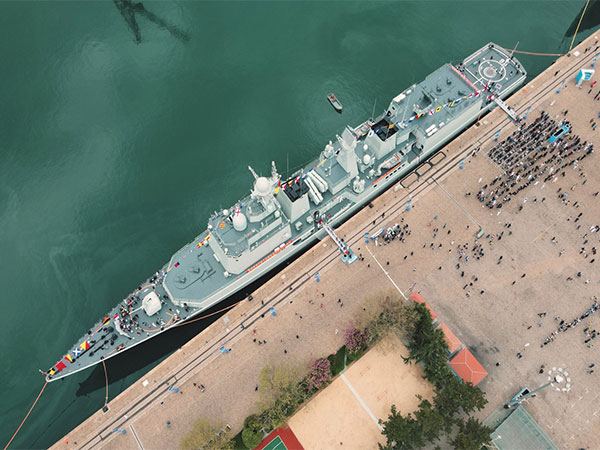Hong Kong, August 27 (ANI): The massive Chinese-flagged container ship manoeuvred into the American port. Suddenly, the roofs of innumerable shipping containers aboard simultaneously rose thanks to their secretive, internal hydraulics, because something even more sinister was contained within. From some containers, countless cruise missiles and anti-ship missiles
blasted into the sky in plumes of flame and smoke, whilst from others drones and kamikaze loitering munitions catapulted into the air to spread further destruction against their allotted targets.
Those targets included US Navy (USN) aircraft carriers, warships and submarines moored unsuspectingly inside their nearby naval base. Other targets included adjacent airbases, army and missile facilities and command-and-control nodes. With absolutely no warning time to prepare for the onslaught, targets were hit and ships sank in frothing waters in what constituted Pearl Harbor 2.0. This scene was not occurring in just one location, but coordinated and devastating attacks were occurring all over the USA. In a single stroke, China decimated the might of the USN…
Such a scenario may sound like the stuff of fiction from a Tom Clancy novel. However, China and its People’s Liberation Army (PLA) already have many of the tools necessary to conduct this type of sudden attack.
In fact, Thomas Shugart, Adjunct Senior Fellow for the Defense Program at the Center for a New American Security (CNAS), recently warned of such an event in a series of tweets on X (formerly Twitter). He posted, “What if I told you that, as I type this, there was a vessel, associated with the Chinese PLA, that ‘could’ be equipped with many dozens of anti-ship cruise missiles – and was parked less than 4 miles from the bulk of the US Atlantic Fleet. Well, guess what: it’s happening – for real.”
Shugart made the remark after the massive 366m-long container ship COSCO Sakura arrived in Norfolk, Virginia on August 21. Built in 2018, this vessel carrying more than 14,000 shipping containers is owned by COSCO Shipping. She was built by Jiangnan Shipyard, which also constructs PLA Navy (PLAN) warships and completed China’s newest aircraft carrier Shandong.
“COSCO Sakura’s path into Norfolk took it past Norfolk Naval Station, within only a few hundred yards of its piers, including those for nuclear submarines and near-irreplaceable aircraft carriers. Presumably it’ll depart the same way,” Shugart noted. The American academic calculated that, fully loaded, Sakura has a topmost layer of 380 containers. “If only, say 10%, of those containers were used for munitions, they could, for example, field 144 cruise missiles and 252 quadcopters, more than enough to devastate every warship at Norfolk, and able to reach land targets across the mid-Atlantic and well past DC.”
Although obviously a doomsday prediction, Shugart, a former USN submarine warfare officer, explained how it could hypothetically come to fruition since the Chinese government has entwined military and civilian capabilities via its civil-military fusion policy. “The company that owns and operates the ship, COSCO Shipping Lines Ltd, is part of the COSCO Group, a Chinese state-owned company that is one of the largest shipping companies in the world. The group works directly with the PLA on a routine basis, providing support to deployed PLA warships through the shipping line.”
Thanks to such opaque state support, Chinese companies dominate the globe’s maritime supply chain and is home to seven of the world’s ten busiest ports. With capacity doubling over the past decade, China now controls the world’s largest shipping fleet by gross tonnage, plus it produces more than 95% of shipping containers. With at least 90% of global trade traveling by sea, China is a mighty force. Last year, China completed construction of 42.3 million deadweight tons of merchant shipping, up 11.8% on the year before. This level of ship construction equaled 50.2% of global output.
A 2020 report by the US-based Center for Strategic and International Studies stated, “COSCO Shipping is widely recognized as the maritime supply arm of the PLA, and has provided logistical support to the PLA Navy’s escort operations in the Gulf of Aden since 2008.”
The PLA also depends on a fleet of roll-on/roll-off (Ro-Ro) ferries. Although “civilian” owned, they act as an auxiliary support fleet whenever the PLA needs them. Some vessels have been modified to serve as adjunct amphibious assault ships, and they regularly participate in military landing exercises. In fact, according to the 2016 National Defense Transportation Act, Shugart said, “New Chinese ships are built to national defense standards, and Chinese organizations can be required to support China’s national defense requirements.” This law covers five categories of vessel – container ships, bulk carriers, break bulk ships, Ro-Ro ferries and multipurpose vessels.
Emma Salisbury, a Seapower Research Fellow at the Council on Geostrategy in the UK, explained, “As there are no official numbers available, estimates vary wildly on how many civilian vessels could or would be made available to the PLAN during a conflict, much less how quickly they could be usefully integrated into military operations. However, some estimates contend that, if China requisitioned its entire dual-capable civilian fleet, that alone would give it more tonnage than the total American amphibious assault.”
Emphasizing the PLA’s employment of civilian vessels, a report by the China Maritime Studies Institute (CMSI), published in January by the US Naval War College, concluded, “As of 2023 and probably through at least 2030, the PLA’s reserve fleet of civilian ships is probably unable to provide the amphibious landing capabilities or the over-the-shore logistics in austere or challenging environments necessary to support a major cross-strait invasion of Taiwan. However, 2023 activity has demonstrated significant progress toward that end.”
Indeed, 33 civil maritime-military events occurred in China last year, of which 16 were classed as significant or major. In total, 39 Chinese civilian ships spent a combined 812 ship-days in support of PLA activities in 2023. The CMSI report also noted the first use of large deck cargo ships to support PLA exercises. “While not as capable as large, oceangoing ferries, China’s civil fleet boasts dozens of large deck cargo ships and may provide the PLA with the lift capacity necessary to eventually support a large cross-strait operation.”
The study’s author, J. Michael Dahm, further highlighted, “Of note, 2023 did see increased inter-theater coordination, including synchronized civil maritime military events across the PLA’s military theaters. Many of the ships, and presumably crews, that participated in 2023 events had not previously supported military activity, indicating the PLA may be attempting to increase the level of military experience across China’s civil fleet. The PLA continues to advance core capabilities for the large-scale lift of PLA troops and equipment into undefended, captured ports, capabilities that may be leveraged in a cross-strait invasion of Taiwan.”
Returning to the opening scenario in this article, it is clear the PLA has deliberately planned the employment of merchant shipping to support its activities. Salisbury pointed out, “Many vessels may indeed end up used for military purposes, reflecting the PRC’s broader national strategy of military-civil fusion. Certainly, the PLAN is dangerously eroding the principle of distinction that is central to the law of armed conflict, blurring the distinction between civilians and combatants, while confusing assessment of what vessel is a legitimate military target.”
China is deliberately doing this in the South China Sea, employing maritime militia and supposed “fishing boats” to prosecute territorial claims using gray-zone tactics. It engenders hesitancy in victims because they do not know who they are dealing with.
With an established track record in such subterfuges, could China take it to a new level by launching sudden missile attacks? If asked to do so, Chinese state-owned enterprises like COSCO Shipping would have little choice. Shugart pointed out “the company leadership has dual loyalty – as leaders both of the company and representatives of the Chinese Communist Party (CCP)”.
For instance, COSCO’s Chinese-language website declares its party group will “unswervingly adhere to the party’s leadership over state-owned enterprises”. This CCP control is evinced by the fact that commercial vessels of state-owned shipping companies, especially those traveling overseas, have a political commissar aboard. They are the second-most senior officer, and are often former PLAN members.
In another CMSI report published this month, author Conor M. Kennedy explained, “The primacy of politics in the Xi Jinping era has further highlighted the party’s role within state-run shipping and has resulted in efforts to revitalize the ship political commissar system in the largest shipping conglomerate, COSCO Shipping.” Kennedy said the system helps assert party control. “The ship political commissar has an important leadership and supporting role when ships are tasked to carry out missions of national significance or in support of the military … In some sectors, such as Ro-Ro ferry operators, the position may have a greater role in providing support to the military, perhaps through management of militia organizations.”
Some might say it is a leap for China to put missiles inside disguised shipping containers. However, it has already done so. At Airshow China in Zhuhai, China Aerospace Science and Industry Corporation (CASIC) – China’s largest missile manufacturer – exhibited a 30-foot containerized missile system in 2022.
Shugart noted, “While ostensibly for coastal defense, these systems are also advertised for their ‘capability to disguise’ themselves. The systems displayed are capable of carrying four missiles – big ones like the YJ-12 supersonic anti-ship missile and the anti-ship YJ-18, which has a land attack variant and a range of up to 540km.”
The containerized system includes an operator’s control station, power generator and launcher, meaning it does not require an external power source to operate. Potentially, they could launch from land or from aboard vessels or trucks. A CASIC spokesperson told the Global Times tabloid back in 2022, “The launch system can connect with various independent detection and command units such as early warning aircraft, maritime patrol aircraft and shore-based radars. It could receive target information from those external sources through encrypted data.”
CASIC said of the YJ-18, “The missile is designed for hidden attacks, can travel long distances, has high damage output and is easy to use.” Further, “The container-type launch system can change its firing angle at will, or even launch the missile vertically.” Like missiles, quadcopters and attack drones can also be stashed in disguised shipping containers.
Is this all too far-fetched? Shugart pointed out, “It’s worth understanding that Chinese military writings are obsessed with striking by surprise to seize the initiative, particularly against a ‘powerful enemy’, and that the best way to destroy enemy ships is in port.” Referring to his initial observations about COSCO Sakura, Shugart explained, “To be clear, I’m not saying THIS SHIP is likely to be armed or doing anything nefarious. But for the reasons above, one much like it could be at some other time, in some other place, in advance-planned Chinese military aggression.”
Pondering what should be done about such threats, Shugart recommended: “The US government already has sanctions in place against a long list of companies that support the PLA. It seems entirely reasonable that a company like COSCO could be sanctioned. Portions of it already have been, though for different reasons (e.g. shipping oil to Iran). Some might say it would cause economic disruption to ban COSCO (or other PLA-associated) ships from US ports, and that might be true. But I think we have to weigh that against the very real military risk we’re accepting (including intel collection) by routinely allowing them in.”
Shugart argued that, while the USA itself might also use transportation services of merchant shipping under its Maritime Security Program, China has taken it to a whole new level. Beijing deliberately builds commercial ships to minimum mandated specifications that permit naval use, exercises political control over them with its commissars, and employs them routinely in military exercises.
The CNAS scholar concluded, “The recent CCP Third Plenum indicated that we should expect ever-deeper Chinese civil-military integration. Perhaps we should take them at their word, and treat companies like COSCO as the adjuncts of the PLA that they increasingly seem to be.” (ANI)
Disclaimer: This story is auto-generated from a syndicated feed of ANI; only the image & headline may have been reworked by News Services Division of World News Network Inc Ltd and Palghar News and Pune News and World News
HINDI, MARATHI, GUJARATI, TAMIL, TELUGU, BENGALI, KANNADA, ORIYA, PUNJABI, URDU, MALAYALAM
For more details and packages
















